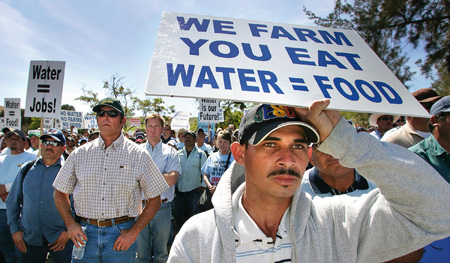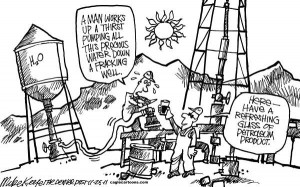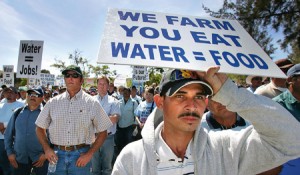July 15, 2014 – As I scanned the pages of my morning business-oriented newspaper I noted an opinion piece that suggested a future of water wars brought on by freshwater scarcity. And then when I started my computer my alerts led me to a new series of reports from London’s prestigious Financial Times. The subject – a world without water.
Two weeks ago I wrote that freshwater scarcity may be our biggest climate change adaptability challenge. Well it seems I am not the only one speaking to the crowd about this very important issue of the 21st century. The Financial Times report, however, takes a different approach to the subject, looking at its impact on commerce. It cites Coca-Cola, Nestle, BG Group, antero Resources, Rio Tinto, BHP Billiton, Ford and EDF as companies in the throes of addressing freshwater scarcity impacting production. Some like BHP Billiton and Rio Tino are investing in deslination projects. Others are closing plants when freshwater scarcity puts them in conflict with local farm and urban populations trying to preserve what little of the resource they have.
For Coca-Cola, the 24th largest industrial consumer of water in the world, it means spending $2 billion U.S. to reduce freshwater use and improve water quality in its plant and corporate operations. The company has even donated millions to the World Wildlife Fund to improve a river environment where Coca-Cola has an operation 160 kilometers north of London, United Kingdom.
Coca-Cola’s $2 billion is considered a small amount when compared to the total companies are spending to address freshwater and water quality issues. The Financial Times reports that since 2011 companies have invested $84 billion U.S. to obtain, conserve and manage their freshwater supplies globally. And the water market worldwide is estimated to be worth $550 billion and expanding at an annual rate of 3.5%.
For Nestle the water crisis is one of their highest priorities. Peter Brabeck, Chairman, is quoted in the Financial Times report as stating: “Humankind is running out of water at an alarming pace….we’re going to run out of water long before we run out of oil.” The company when assessing new business proposals has introduced an internal “shadow price” of $1.00 U.S. per cubic meter for areas where water is abundant, and $5.00 per cubic meter where water is more scarce.
If you remember Robert Redford’s 1989 film, The Milagro Beanfield War, a story about a water war between a New Mexico developer and a local farmer, it appears that it will be repeated in real life across this planet in many locations during the 21st century.
In Brahma Chellaney‘s morning article in today’s The Globe and Mail he states that many countries and cities will run out of freshwater and cites Sanaa, Yemen as the first capital city to go completely dry. Chellaney gives other examples of impending water crises and conflict zones. He talks about the damming of the upper Brahmaputra in China (see my posting on The Rivers of Asia) potentially leading to water refugees in India and Bangladesh. He talks about Ethiopia’s development of The Blue Nile with a proposed dam that could lead to a war with Egypt. And he takes a quote attributed to Mark Twain during the first California Water Wars, a struggle between Arizona and California over access to the Colorado River for a water starved Los Angeles, in which Twain purportedly stated, “whiskey is for drinking and water is for fighting over.”

















Kudos for you to point out this problem
Water Shortage = Great for companies that sells water, bad for the rest of us
Food shortage and starvation could be reconciled by handling our resources more responsible and solved within 6 months. We produce twice as much food on a global scale as we consume – the rest is waste – and the resources we spend on weapons and warfare during 2 weeks would be enough to feed every person on this planet for one year.
When it comes to water the situation is very different:
It is true that many people lack access to clean water as we have depleted our supplies or polluted them. The solution – I think – is a new form of energy that is affordable, accessible and clean. What I mean by this is that the water problem is actually an energy problem. If we want to solve water we have to first solve energy – and we must.
2 / 3 of this planet surface is water – there is water in our atmosphere and pockets of vast supplies of water deep underground. If we develop clean “Cold Fusion” / LENR we can desalinate sea water, extract clean water from the atmosphere and pump water from deep underground.
Cold Fusion will be very cheap – it does not pollute and its a nearly infinite energy supply.
Take this to the market and we solve water in the blink of an eye.
Another benefit than making readily available new water supplies is the promise to greatly improve recycling and stop pollution our current supplies. (China is filled with pink, blue and green sea`s due to pollution from for example textile industry)
Transforming energy, water and food would be a great boost to the financial market and we dont have much options. If clean water is not a problem for YOU today then think again because what is a problem to your neighbour will soon be a problem for you as he will do whatever he can to supply water for his family/industry to secure survival.
Please – for more information check out my webpage
Information and Technology can solve all our problem
Dr B Mihajlovski
The mascot of Cold Fusion
Hi Dr. Mihajlovski, Putting cold fusion and freshwater scarcity in the same sentence makes little sense to me. Cold fusion remains an unproven technology. We have had a number of demonstration devices that have yet to move beyond lab experiments. Not one commercial application has been developed. I assume you associate freshwater and cold fusion together because as a cheap energy source it could be used to filter grey water, desalinate seawater, and purify water from existing sources. Well, when you have a cold fusion device that produces consistent replicable results, and have it working in a commercial application, then I will sit up and take notice. Otherwise, I refer you to the many articles on my blog site written about LENR and other cold fusion technologies. None survive the leap from the lab to a real product, and it is not for want of trying.